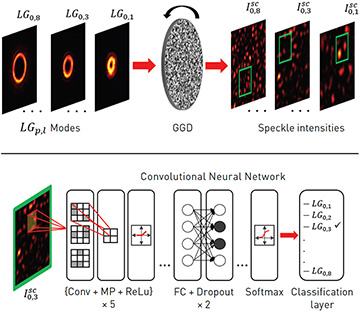 Top: Generation of speckle patterns by illuminating the OAM modes on ground-glass diffuser. Bottom: A region of 512×512 pixels (green box in upper diagram) is randomly selected and fed to the CNN. [Enlarge figure]
Top: Generation of speckle patterns by illuminating the OAM modes on ground-glass diffuser. Bottom: A region of 512×512 pixels (green box in upper diagram) is randomly selected and fed to the CNN. [Enlarge figure]
Orbital angular momentum (OAM) beams—structured light with a spatial degree of freedom due to the helical phase front—have emerged as a potential candidate for increasing the bandwidth and information-carrying capacity of communication links. In theory, OAM beams can have infinite orthogonal states on propagation, meaning that the transmission capacity can be boosted by sending multiple data streams on top of one another.1
The real challenge lies in the detection of such OAM modes, which are prone to distortion on propagation. Artificial intelligence (AI) offers the promise of boosting the performance of communication systems by replacing physical components, such as mirrors and beam splitters, with machine-learning and deep-learning models, thereby reducing complexity and alignment constraints.2 Even so, current state-of-the-art AI methods require capture of the entire modal field for authentic prediction.
To resolve this issue, we have developed a speckle-based recognition method that does not require capture of the entire modal field, but for which any region of the speckle field having a sufficient number of speckle grains is sufficient to measure the OAM mode.3 To develop an OAM classification model we have used Alexnet,4 a pretrained convolutional neural network (CNN) known for its high accuracy and moderate computational load. As pre-trained networks have already learned some features, they use fewer computational resources and reduce training time compared with the networks trained from scratch.
The speckles are generated by first passing OAM modes through a ground-glass diffuser (GGD). Then, a randomly selected region of 512×512 pixels from the captured intensity patterns is used for training and testing the model. The speckle structure formed at the detector does depend on the inhomogeneity size of the GGD; therefore, for more robustness and generality, we have trained the network on a cumulative dataset containing speckle patterns generated by three GGDs with different grit polishes. We achieved an accuracy of greater than 96% for the classification of eight OAM modes with topological charge l = 1 to 8.
In our speckle-based learning approach, the model learns the underlying features of speckle distribution. The new dimensions of OAM modes can then be studied by exploiting the features learned by the CNN.
Acknowledgment: VK acknowledges SERB India funding (SRG/2021/001375).
Researchers
Venugopal Raskatla, Purnesh Singh Badavath and Vijay Kumar, National Institute of Technology, Warangal, India
Satyajeet Patil and R. P. Singh, Physical Research Laboratory, Ahmedabad, India
References
1. A.E. Willner et al. Appl. Phys. Rev. 8, 041312 (2021).
2. T. Doster and A.T. Watnik. Appl. Opt. 56, 3386 (2017).
3. V. Raskatla et al. J. Opt. Soc. Am. A 39, 759 (2022).
4. A. Krizhevsky et al. Commun. ACM 60, 84 (2017).
